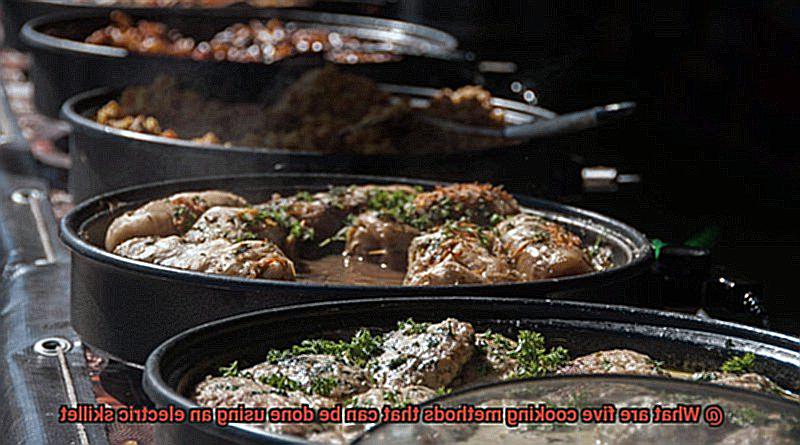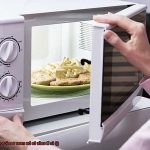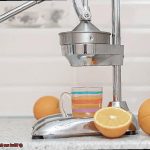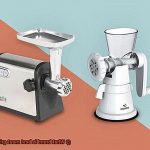Cooking can be a daunting task, but with the right tools and techniques, it can also be a fun and enjoyable experience. That’s where an electric skillet comes in handy. This all-in-one piece of equipment is a must-have for any cooking enthusiast who wants to experiment with different cooking methods beyond the usual frying and grilling.
Are you curious about what other cooking methods you can try with an electric skillet? Look no further because I have five exciting ways to cook using this versatile kitchen tool.
First up is braising, a method that involves searing meat and then slow-cooking it in a flavorful liquid. Sautéing is another quick and easy way to cook vegetables or meat with just a little bit of oil. You can even roast your favorite cuts of meat by placing them in the skillet and cooking them under a lid. And don’t forget about steaming. With an electric skillet, you can easily steam your veggies to perfection by adding water and a steamer basket. Lastly, baking is also possible with this amazing kitchen gadget.
If you’re intrigued by the possibilities of an electric skillet, keep reading. We’ll explore each method in detail so that you can get the most out of your electric skillet and become a pro at cooking delicious meals in no time.
Contents
Advantages of Using an Electric Skillet
Say hello to the electric skillet, a versatile kitchen appliance that offers a range of benefits for any home cook. Let’s explore the advantages of using an electric skillet:
- Accurate Temperature Control: One of the biggest advantages of using an electric skillet is its precise temperature control. With a built-in thermostat, you can easily set the temperature to cook delicate foods like fish and eggs evenly without burning.
- Easy Cleanup: Most electric skillets come with a non-stick surface that prevents food from sticking, which means cleaning up is a breeze. Wipe the skillet down with a damp cloth or toss it in the dishwasher for hassle-free cleanup.
- Energy Efficiency: Electric skillets use less electricity than traditional stovetop skillets, making them an energy-efficient choice to save money on your bills and reduce your carbon footprint.
- Portability: With its lightweight design, electric skillets are easy to move around and ideal for small kitchens or outdoor cooking. Take it with you wherever you go for more flexibility in your cooking.
- Versatility: An electric skillet isn’t just for frying; it’s a versatile appliance that can sauté, braise, simmer, and even bake. You can cook almost anything in an electric skillet, making it an essential tool in any kitchen.
Five Cooking Methods That Can Be Done Using an Electric Skillet
If you’re looking to take your cooking game to the next level, investing in an electric skillet is a must. This versatile appliance can help you whip up restaurant-quality meals in no time, while also saving you energy and effort. Here are five exciting cooking methods that can be done using an electric skillet:
- Sauteing: When you’re short on time but still want to enjoy healthy and delicious meals, sauteing is the perfect option. Simply heat up some oil in your electric skillet, add your favorite veggies and proteins, and keep stirring until they’re cooked through.
- Frying: From crispy fried chicken to perfectly cooked vegetables, an electric skillet is an excellent tool for frying. Make sure to use enough oil to cover the food evenly and heat it up to the right temperature before adding your ingredients.
- Grilling: Indoor grilling has never been easier thanks to electric skillets. Set your skillet to a high temperature and grill your favorite meats and veggies for that perfect charred flavor.
- Braising: For tougher cuts of meat that need to be cooked low and slow, braising in an electric skillet is a great option. Add your ingredients along with some flavorful liquid like broth or wine, cover it up, and let it simmer until everything is tender and juicy.
- Stir-frying: If you’re craving a quick and tasty stir-fry, look no further than your electric skillet. Heat up some oil, add your choice of veggies, protein, and sauce, and keep stirring until everything is cooked to perfection.
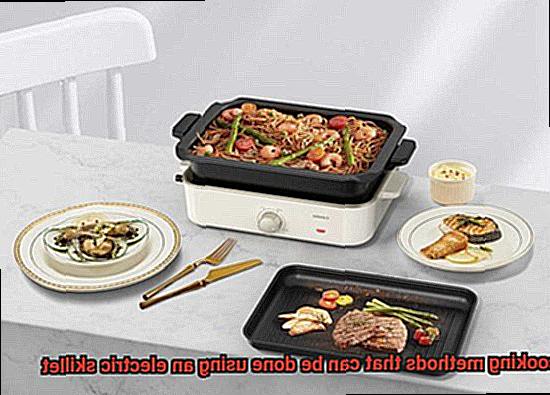
Sautéing
Then let’s talk about sauteing – a quick and easy cooking method that can be done using an electric skillet.
Sauteing involves quickly cooking small pieces of food in a shallow pan over high heat, and it’s a fantastic way to cook vegetables, meats, and seafood while preserving their natural flavors and textures. And when it comes to sauteing in an electric skillet, you’re in luck because it provides even heat and precise temperature control.
To get started with sauteing in an electric skillet, you’ll need to preheat the skillet to the desired temperature. This step is crucial to ensure that the food cooks evenly. Once your skillet is heated, add a small amount of oil or butter to the pan. Give it a few seconds to heat up before adding any ingredients.
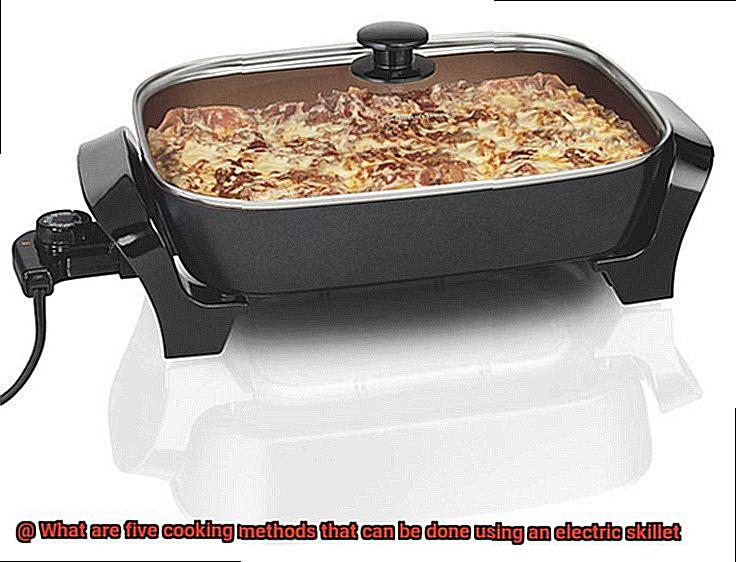
Now it’s time to add your ingredients. Vegetables, meats, and seafood are all great options for sauteing. Just be sure not to overcrowd the skillet – this will ensure that everything cooks evenly. Cook your ingredients for 2-3 minutes, stirring frequently. Remember that sauteing is meant to be a quick cooking method, so don’t overcook your ingredients.
But sauteing isn’t just great for cooking main dishes – it’s also ideal for creating sauces and gravies. Brown ingredients like onions and garlic before adding liquid to give your sauces more depth of flavor.
Frying
If you’re looking for a quick and easy way to fry up some delicious food, an electric skillet is the perfect tool for the job. With its even heating and versatility, you can fry up anything from chicken to veggies with golden brown perfection. But before you dive in, there are a few things to keep in mind.
First and foremost, the type of oil you use in your electric skillet can make or break your frying experience. You want an oil with a high smoke point that can withstand high temperatures without burning or smoking. Vegetable oil, canola oil, and peanut oil are all great options that will give you the crispy results you’re looking for without sacrificing taste.
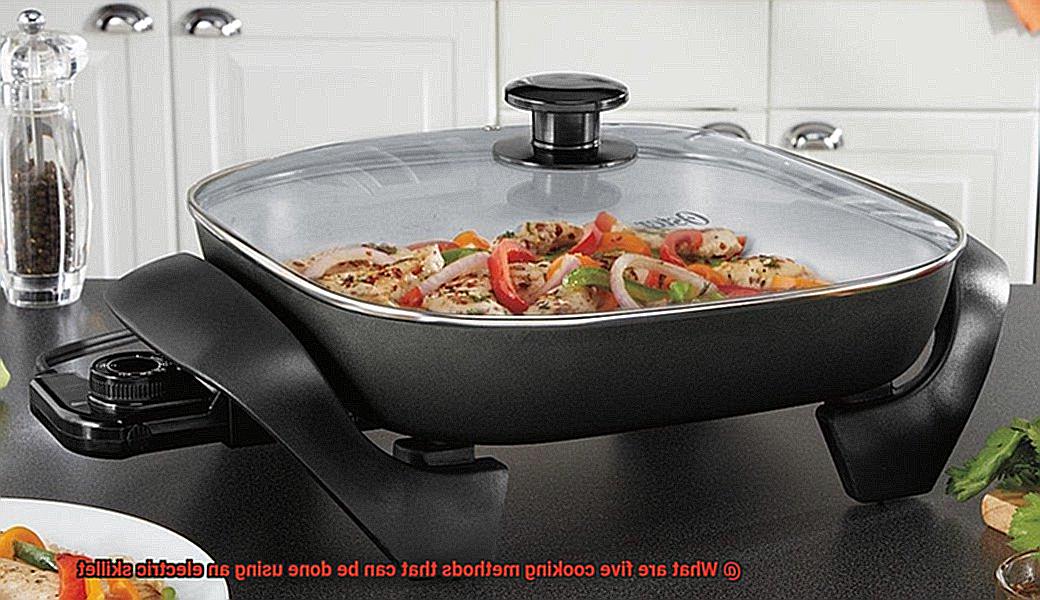
Once you’ve got your oil sorted, it’s time to heat up your skillet. Preheat it to around 375°F (or according to your recipe) and add enough oil to cover the bottom of the skillet. Let the oil heat up for a few minutes before adding your food.
When it comes to frying in an electric skillet, overcrowding is a big no-no. If you put too much food in the skillet at once, it can cause the temperature to drop and result in soggy, greasy food. Fry your food in batches if necessary for even cooking and best results.
As your food fries up to a crispy golden brown, keep an eye on the internal temperature of meat to ensure it reaches at least 165°F for safe consumption. When your food is done frying, use tongs or a slotted spoon to remove it from the skillet and place it on a paper towel-lined plate to absorb any excess oil.
Simmering
Fear not, because simmering is here to save the day. This cooking technique requires low heat and slow cooking, making it perfect for breaking down tough ingredients and creating tender, flavorful dishes. And what better way to achieve this than with an electric skillet?
To start simmering with an electric skillet, fill it with liquid like broth or water and bring it to a gentle boil. Then, reduce the heat to low and let the liquid simmer away. This is where the magic happens – your ingredients slowly cook and meld together to create a symphony of flavors.
But don’t stop there. Simmering is perfect for creating soups, stews, and sauces that will have your taste buds dancing with delight. And if you’re feeling adventurous, try poaching eggs or cooking delicate fish using this method for a gentle yet effective cooking experience.
When using an electric skillet for simmering, be sure to stir occasionally to prevent sticking and burning on the bottom. You can also cover the skillet with a lid to lock in moisture and enhance the flavor of your dish.
Boiling
Boiling is a cooking technique that has been used for centuries. It involves heating water or any other liquid until it reaches its boiling point. However, did you know that using an electric skillet can take your boiling game to the next level? If you’re looking for a healthy and easy way to cook your favorite foods, boiling in an electric skillet is definitely worth a try.
Let’s explore the advantages of boiling in an electric skillet:
Firstly, electric skillets are designed to heat up quickly and maintain a consistent temperature, which is perfect for boiling. This means that your water will start boiling faster and stay at the right temperature throughout the cooking process, ensuring that your food cooks evenly every time.
Secondly, with an electric skillet, you have complete control over the temperature. This means that you can avoid overcooking your food and keep it tender and flavorful. Moreover, you can add salt, herbs, or spices to the water for extra flavor.
Thirdly, boiling is a healthy cooking method because it doesn’t require any oil or fat. This makes it a great option for those who are watching their weight or trying to eat more healthily.
Lastly, boiling is a versatile cooking method that can be used to cook various foods such as vegetables, rice, potatoes, pasta, and eggs. Electric skillets make it easy to boil any food you want without having to worry about a pot boiling over on the stove.
e. Grilling
Grilling is a beloved cooking method that brings people together, especially during the summer months. But what about those times when the weather isn’t cooperating, or you don’t have access to a traditional grill? Fear not, because an electric skillet is here to save the day. With its convenience and versatility, grilling on an electric skillet is an experience that should not be missed.
To get started, preheat your electric skillet to a high temperature so your food cooks evenly and achieves those iconic grill marks. With this method, you have absolute control over the temperature, ensuring that your food is cooked just the way you like it – no more worrying about undercooked chicken or overdone burgers.
When it comes to grilling on an electric skillet, the possibilities are endless. From classic burgers and hot dogs to succulent steaks and juicy chicken breasts, these dishes can all be made using an electric skillet. And let’s not forget about the vegetables – grilling zucchini, peppers, and onions brings out their natural sweetness and adds a delicious smoky flavor.
But what really sets grilling on an electric skillet apart is the ability to experiment with flavors. Try out different marinades and rubs to add extra depth to your dishes. Whether you prefer a spicy kick or a sweet glaze, there’s no limit to what you can create.
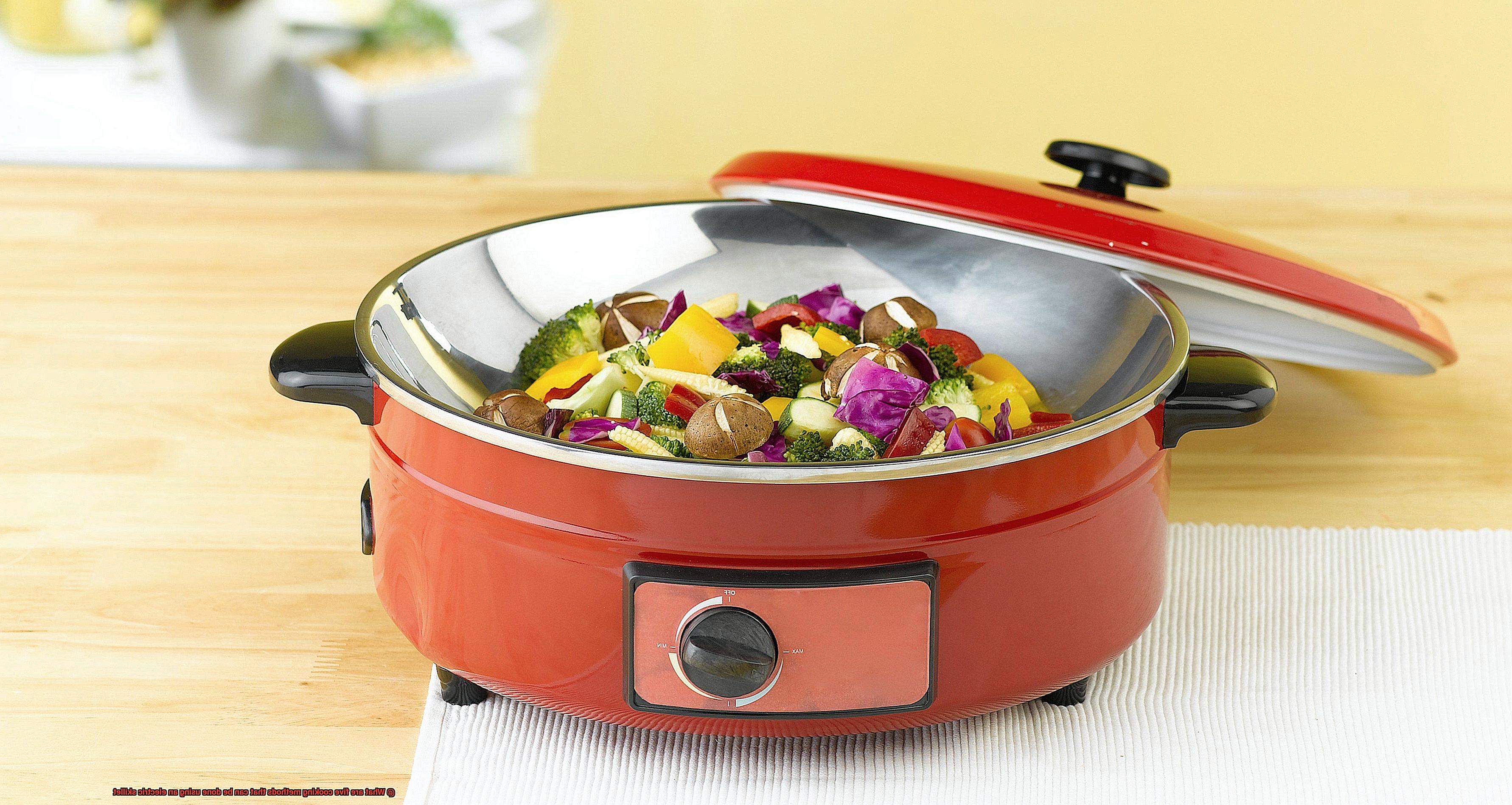
Tips for Perfectly Cooking with an Electric Skillet
Cooking with an electric skillet is a convenient way to prepare meals, but it can also be a bit tricky. To avoid common mistakes and ensure perfectly cooked meals every time, here are some tips to follow.
Properly preheat the skillet
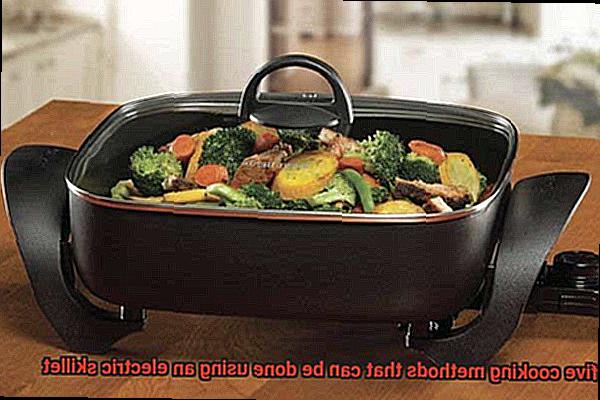
Before adding any ingredients, preheat your skillet for at least five minutes. This allows the heat to evenly distribute throughout the surface of the skillet, preventing hot spots and ensuring even cooking.
Choose the right temperature
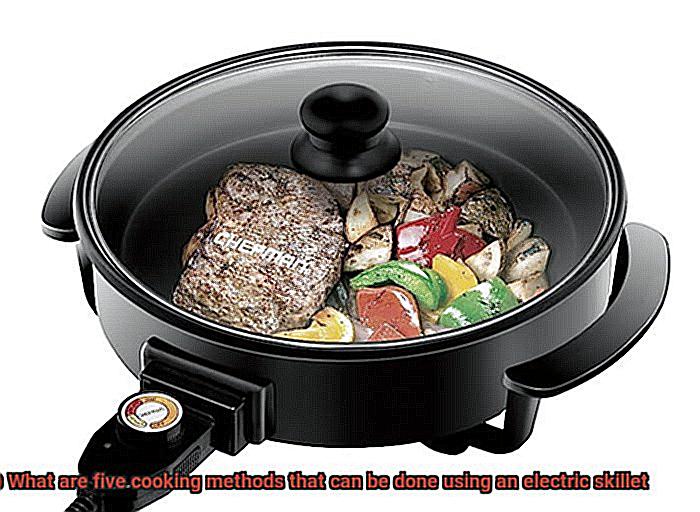
Different foods require different cooking temperatures, so it’s important to choose the right one for the type of food you’re cooking. For delicate foods like eggs or pancakes, a lower temperature setting is ideal, while meats and vegetables may require a higher setting.
Use the right amount of oil
Avoid using too much oil, which can make your food greasy, or too little, which can cause sticking. Use a light coating of oil or non-stick cooking spray to prevent sticking and ensure even cooking.
Avoid overcrowding
Overcrowding your skillet can cause uneven cooking and prevent your food from browning properly. Leave enough space between each ingredient to allow for even cooking.
Adjust temperature as needed
Keep an eye on the temperature throughout the cooking process and adjust as needed. This ensures that your food cooks perfectly without burning or undercooking.
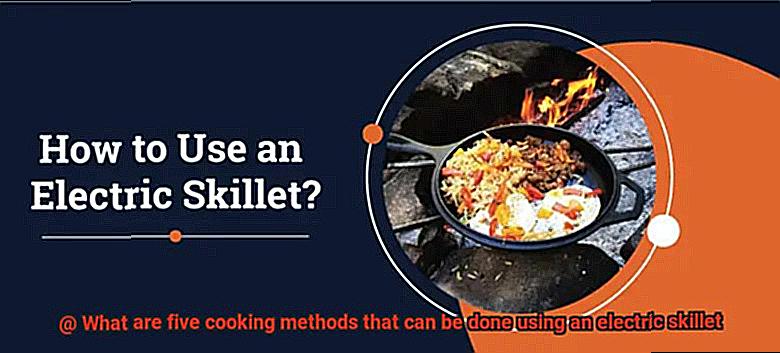
Use the right utensils
Always use silicone, nylon, or wooden utensils when cooking with your electric skillet. Metal utensils can scratch the non-stick surface of the skillet and damage it over time.
How to Clean and Maintain Your Electric Skillet
An electric skillet is a fantastic kitchen appliance that can make cooking a breeze. From whipping up stir-fries to simmering stews, an electric skillet can do it all. However, to ensure that your electric skillet works optimally and lasts long, you need to clean and maintain it regularly. Here are five sub-sections detailing how to clean and maintain your electric skillet:
Clean After Each Use
One of the first things you need to do to maintain your electric skillet is to clean it after every use. Leaving food residue on the surface can cause damage over time. Ensure the skillet cools before cleaning it with a soft cloth or sponge using mild soap and warm water.
Avoid Submerging in Water
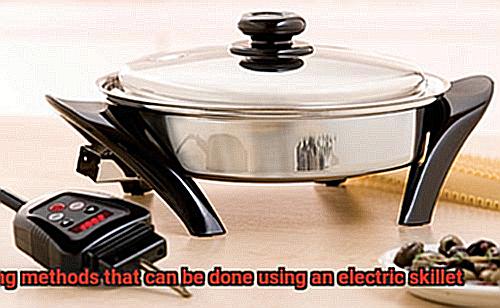
Electric skillets are not waterproof, and submerging them in water can damage the heating element. Instead, wipe the skillet with a damp cloth or sponge.
Store Properly
Proper storage is key to ensuring your electric skillet lasts long. Store it in a cool, dry place away from direct sunlight, moisture, or heat sources. Do not stack heavy objects on top of it as this can damage the non-stick surface.
Avoid Overheating
Do not overheat your electric skillet as this can cause damage to the non-stick surface. Use the temperature control feature to adjust the heat according to your preference.
Use Proper Utensils
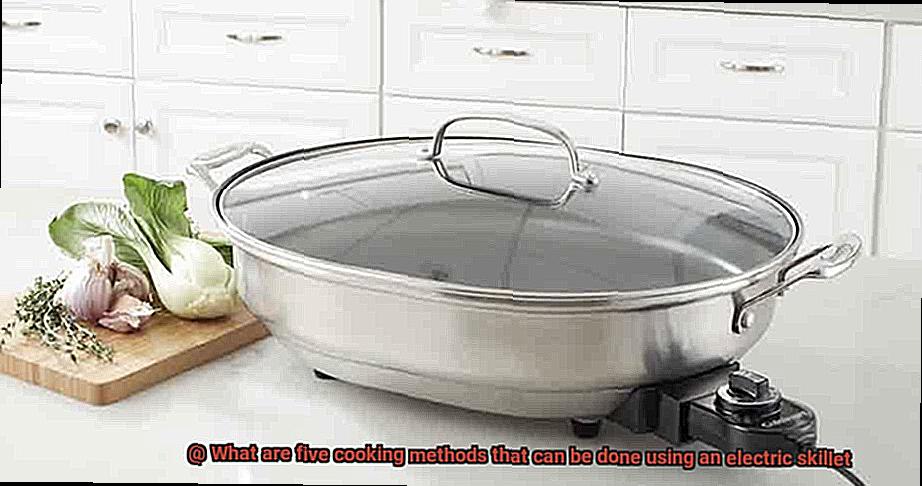
Using metal utensils on the non-stick surface of your electric skillet can scratch it and cause damage over time. Instead, use wooden or silicone utensils when cooking with your electric skillet.
Now that you know how to maintain your electric skillet let’s dive into ways to clean it properly:
Cool the Skillet
Before cleaning, ensure that the skillet has cooled down. Cleaning it while hot can damage the non-stick coating.
Remove the Temperature Control
Detach the temperature control from the skillet by gently twisting and pulling it off.
Wash the Skillet
Use warm soapy water and a soft sponge or cloth to wash the skillet. Avoid using abrasive materials like steel wool or harsh detergents that can scratch or damage the non-stick surface.
Rinse and Dry
Rinse the skillet with clean water and wipe it dry with a soft cloth or towel.
Reassemble
Once the skillet is completely dry, reattach the temperature control knob.
Alternatives to the Electric Skillet
Fortunately, there are many alternatives to the electric skillet that can help you elevate your cooking game. Here’s a list of some of the best:
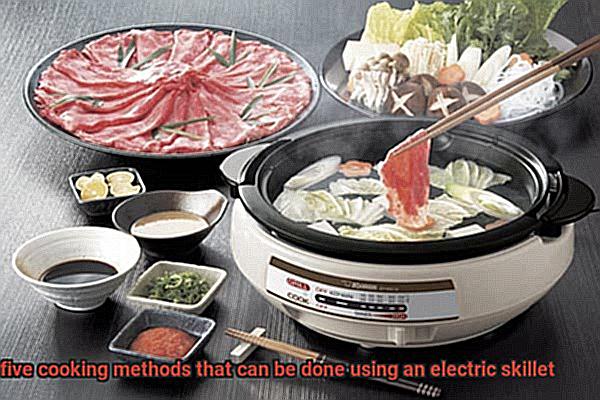
First on our list is the stovetop skillet, a classic kitchen tool that can be used for basic cooking methods such as frying, sautéing, and searing. Although it may not be as versatile as an electric skillet, it provides a touch of nostalgia to your cooking experience.
If you’re missing the taste of grilled meats and veggies but don’t have access to an outdoor grill, consider using a grill pan. This specialized pan has ridges on the surface that mimic grilling marks, adding a delicious charred flavor to your food.
For those who don’t want to keep an eye on their food constantly, a slow cooker is an excellent alternative to the electric skillet. You can cook stews, soups, and other dishes that require long cooking times without having to monitor the temperature constantly.
If you’re looking for a versatile tool that can be used both on the stovetop and in the oven, then look no further than the Dutch oven. This heavy-duty pot is great for baking, roasting, and braising, making it an essential in any kitchen.
Lastly, we have the wok, perfect for stir-frying and other Asian-style cooking methods. Its high sides make tossing ingredients around easy without spilling them over the edge.
Benefits of Using an Electric Skillet Over Traditional Stovetops and Ovens
Look no further than the electric skillet – the ultimate kitchen tool for home cooks and professional chefs alike. With a range of benefits over traditional stovetops and ovens, electric skillets provide convenience and versatility in the kitchen.
First up, even heat distribution. Unlike traditional appliances that have hot spots which can result in uneven cooking, electric skillets provide consistent heat throughout the entire surface. This means your food will cook evenly without the risk of burning or undercooking.
Precision is key in cooking, and electric skillets offer precise temperature control. Adjustable temperature settings allow you to set the temperature to a specific degree, ensuring your food is cooked perfectly every time. Say goodbye to the guessing game of whether your meal is cooked to perfection or not.
Electric skillets are also versatile in their cooking methods. From frying and sautéing to grilling and baking, they can replace several kitchen tools, saving you both space and money.
Cleaning up after cooking can be a hassle with traditional stovetops and ovens, but not with an electric skillet. Most models come with a non-stick surface that makes cleaning up quick and easy with just a few wipes. Plus, many models have removable parts that can be thrown in the dishwasher for even easier cleaning.
Last but not least, electric skillets save time and energy in the kitchen. They heat up quickly and cook meals faster than traditional appliances, making them ideal for busy schedules. Not only do they save time, but they also use less energy than traditional appliances, helping reduce your energy bill and save you money in the long run.
spBzaMc5Pzo” >
Conclusion
In conclusion, the electric skillet is a versatile kitchen tool that can be used for a variety of cooking methods.
From sautéing and frying to grilling and baking, this appliance can do it all. Its adjustable temperature settings and non-stick surface make it easy to cook a wide range of dishes with minimal effort.
Whether you’re preparing breakfast, lunch, dinner, or even dessert, the electric skillet is a convenient option that can save you time and energy in the kitchen.

